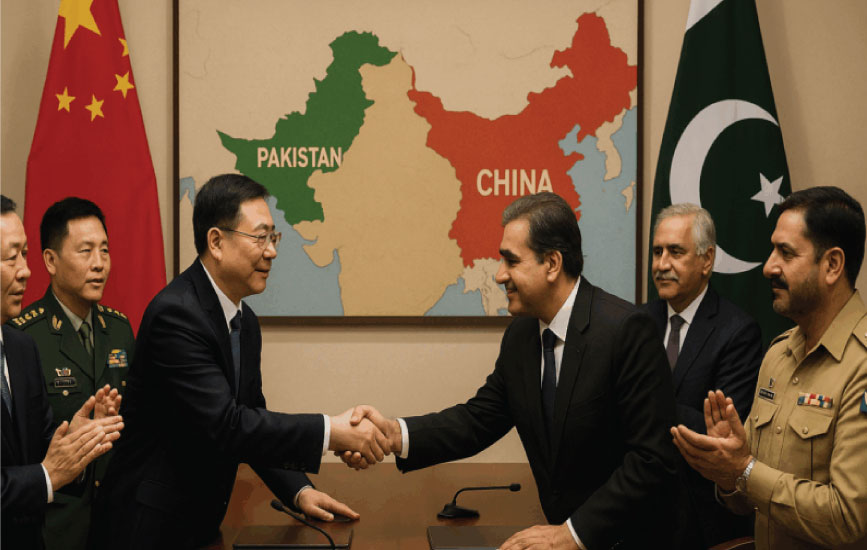Kabul hosted a trilateral conference on August 20, 2025, where delegates from China, Pakistan, and Afghanistan participated. This included China’s foreign minister, Wang Yi, Pakistan’s deputy prime minister and foreign minister, Ishaq Dar, and Afghanistan’s foreign minister, Aamir Khan Muttaqi. As expected, the highlight of the conference was a discussion of cross-border terrorism, political and regional cooperation, and China-Pakistan Economic Corridor (CPEC) expansion.
This is the third trilateral meeting between these countries this year. The issue of terrorism in Pakistan was a top agenda in all three conferences. Apart from trade cooperation and CPEC, it matters most. The truth is that terrorism-related threats have their sources in Afghanistan. Pakistan has thus not only contended with internal insurgents but also with non-state actors based in Afghanistan. These players are aided by regional instability, ideological havens, and a rushed Western departure.
In the Global War on Terror, Pakistan was at the receiving end of a conflict it never initiated, yet it paid with blood and billions of dollars over the past two decades. This involvement led to the deaths of over 70,000 Pakistanis and resulted in losses exceeding $150 billion to Pakistan’s economy, post-9/11. The trauma is deep and the cost staggering, whether it was the school massacre in Peshawar, terror attacks on urban centers, or assaults on security forces. Even today, Pakistan continues to grapple with terrorism, a remnant of the Global War on Terror.
A 2024 report noted that more than 1,600 civilians and security personnel were killed in terror bombings and gun attacks. 2024 appeared to be the deadliest year, as more than 685 servicemen were killed in 444 terrorist incidents. In March of 2025, Pakistan ranked second in the Global Terrorism Index, as terrorist attacks rose by 45 percent.
A new phase in Pakistan’s war on terror began with the launch of Operation Azm-e-Istehkam in June 2024, a multi-faceted counterterrorism initiative aimed at breaking the chain of terrorism-related violence. A distinguishing feature of this operation is its full acknowledgment of cross-border terrorism, particularly that originating from Afghanistan. The operation focuses on improving intelligence capabilities, strengthening diplomatic ties with the Taliban government in Kabul, and aligning border management with broader security measures.
Operation Azm-e-Istehkam could potentially mark a systematic reform in Pakistan’s fight against terrorism, built on a structure centered on intelligence-driven operations, regional cooperation, and social and economic reforms. However, for the operation to be implemented successfully, it must be accompanied by progress across the Durand Line. External sanctuaries in Afghanistan will continue to undermine the internal security gains achieved by Pakistan as long as the country remains a permissive environment for the Tehreek-e-Taliban Pakistan (TTP) and other anti-Pakistan militant groups.
As far as China is concerned, its interest in the Pak-Afghan rapprochement is twofold. One is that it aims to prevent any spillover of terror into Xinjiang province through radical networks. China wants to counter any strategic threat to CPEC, particularly since their officials have already been attacked by insurgents in Baluchistan. China also seeks to hamper the increasing influence of India in Kabul.
Furthermore, the economic presence of China can be used to influence the Taliban to tone down their attitude towards Pakistan. Beijing can contribute to creating integrated security architecture by offering aid, developing infrastructure, and offering trade incentives, especially the prospect of extending the China-Pakistan Economic Corridor (CPEC) to Afghanistan. This might include collective management of the border and repatriation of Afghan refugees, as well as coordinating intelligence.
In July, the Council of Foreign Ministers meeting of the Shanghai Cooperation Organization (SCO) held in Tianjin, China, emphasized the need for Afghan stability and greater cooperation among regional states. Beijing’s message was more than mere diplomacy. It signaled a strategic recalibration. This stance was echoed by Pakistan Foreign Minister Dar and was followed by a series of high-level talks between Pakistan and the Taliban regime, facilitated and encouraged by Beijing.
Previously, in May 2025, a trilateral dialogue was held in China between Pakistan and Afghanistan. The meeting produced a symbolic willingness to reinstate diplomatic relations between Islamabad and Kabul at the ambassadorial level. More importantly, it opened an avenue for future regional security cooperation, not only against TTP terror but also against threats such as East Turkestan Islamic Movement (ETIM) and Islamic State Khorasan Province (ISKP), which have also drawn Beijing’s attention.
These trilateral engagements offer Pakistan two opportunities to internationalize its concerns over cross-border terrorism and the chance to tie those concerns to broader regional stability and economic growth.
China’s mediation introduces a new variable into the equation, shifting the dynamic from a binary of conflict and impunity to a triangle of pressure, cooperation, and mutual interest. Provided it is adequately utilized, the trilateral effort between China, Pakistan, and Afghanistan has the potential to evolve from a symbol into a solid plan—and out of weak diplomacy into stable security.
Qurat-UL-Ain Shabbir is a research officer at CISS.



